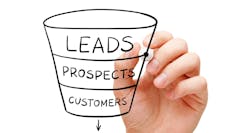Achieving Better Website Conversions, Part 1: Sales Funnel Basics
Understanding and measuring your sales funnel is crucial if you want to grow your business. The first step is attracting prospects to your website. This is when potential customers first learn about your home building brand. It’s important because without filling this top part of the sales funnel, the rest of the funnel can’t function effectively.
The Top of the Sales Funnel: Attracting Prospects
Our series on home builder marketing strategies starts with how to drive traffic to your website.
The sales funnel is a vital framework for converting leads into loyal customers. At the top of the funnel, the focus is on attracting as many prospects as possible—specifically, getting prospects to notice your brand and visit your website.
The primary metric to measure here is impressions-to-visitors (%), which tracks how many people who see your marketing efforts actually click through to your website.
Marketing Strategies to Increase Website Traffic
There are two basic marketing strategies to increase website traffic: Unpaid and Paid. Consider the differences and value of each option within those strategies:
1. Unpaid Digital Marketing Strategies
Organic SEO and content marketing
Organic search engine optimization (SEO) is the backbone of any long-term traffic strategy for your website. By incorporating relevant keywords like “home builder marketing” naturally throughout your site’s content, as well as in your site’s meta descriptions and image alt text, you help search engines understand what your website is about so your site can rank higher in search results.
But SEO isn’t just about keywords, it’s also about providing valuable content that meets your prospects’ needs and can even educate them about the homebuying journey.
That's why content marketing is a critical component of this strategy. Regularly publishing blog posts, how-to guides, and videos that answer common questions can position your website as a go-to resource that provides trusted information for homebuyers.
For instance, creating a detailed guide on “How to Choose the Right Floor Plan” can attract visitors to your website who are just starting their homebuying journey. And, the more valuable and relevant your content, the more likely it is to be shared, linked to, and visited, boosting your site’s authority and traffic over time.
Social media marketing
Social media is another powerful tool for driving traffic to your website. Platforms such as Facebook, Instagram, and LinkedIn allow you to share your content, engage with your audience, and build your brand presence.
Post regularly on social media channels about your projects, share what’s going on behind the scenes, and highlight customer testimonials. Each post also should include a call to action that directs followers to your website.
Engagement is key on social media, so dedicated yourself to responding to comments, participating in discussions, and using features such as stories and live videos to keep your audience engaged.
Social media is valuable for not only helping to drive traffic to your site but also for building a community around your brand, which fosters trust and loyalty.
RELATED
- Customer Experience Metrics: How Builders Can Use NPS
- Top Trends in Digital Sales and Marketing Strategies for Home Builders
- Your Sales Attribution Method Is Lying to You
2. Paid Marketing Strategies
Paid search
Paid digital advertising can provide a quick boost in website traffic for your brand.
Pay-per-click (PPC) advertising through platforms such as Google Ads allows you to target specific demographics and keywords, ensuring your ads are seen by people who are actively searching for home builders. These ads appear at the top of Google search results, making them a powerful tool for driving immediate traffic.
Banner advertising
Banner advertising on relevant websites also can increase your brand’s visibility. These visual ads ideally attract consumer attention and drive clicks, especially when placed on popular industry sites or local real estate portals.
Both PPC and banner ads should have clear calls to action that lead visitors directly to your website.
Paid social media advertising
Paid social media advertising is another great tool for home builders. On platforms such as Facebook, Instagram, and LinkedIn, you can create highly targeted ad campaigns based on consumer demographics, interests, and behaviors.
These ads can reach potential homebuyers who may not be actively searching for a home to buy but are likely interested in your offerings.
Use compelling visuals and clear calls to action to capture attention and direct potential homebuyers to your website.
Listing websites and offline advertising
Don’t overlook the power of listing websites and offline advertising for driving traffic to your website. Listing your services on popular home builder directories and real estate websites can drive significant traffic to your site. Ensure your listings are optimized with high-quality images, detailed descriptions, and links back to your site.
Offline advertising, such as print ads in local newspapers, billboard advertising, and even sponsorships of local events, can also be effective. These methods reach audiences that may not be actively searching online for a home but are still potential customers. And remember that including your website URL in all offline advertising is essential to drive traffic.
How to Measure the Effectiveness of Your Marketing
The primary metric to track at this stage is the impressions-to-visitors ratio. This shows how many people who see your ads or content actually visit your website. A high impressions-to-visitors percentage indicates your marketing efforts are effectively drawing in prospects.
Taking those metrics a step further, to get a more comprehensive view of your marketing performance, you can track secondary metrics such as cost per impression, cost per click, and total visits as well.
- Cost per mille (CPM): Also known as cost per thousand, is a digital marketing metric that measures how much an advertiser (you) is paying for 1,000 impressions of an advertisement on a web page. Lower CPM means you’re getting more visibility for less money.
- Cost per click (CPC): Measures how much you’re spending for each click on your ad. Lower CPC means more clicks for your budget.
- Total visits: Tracks the total number of visitors to your website. This helps you gauge the overall effectiveness of your marketing strategies.
These metrics will help you understand the efficiency of your marketing spend and the overall reach of your campaigns.
RELATED
- Lost Leads? Engage Your Secret Weapon: The Lost-Customer Survey
- Buy It Now: Self-Service and the Homebuying Experience of the Future
- Your Next, Best Sales Tool: the Marketing Technologist
Digital Marketing With a Continuous Improvement Approach
Regularly reviewing your marketing analytics is crucial for continuous improvement. Tools such as Google Analytics provide insights into where your traffic is coming from, how visitors are interacting with your content, and which online marketing strategies have the best return on investment.
Use this data, along with reports from inbound sources, to tweak your approach and optimize your efforts to keep attracting high-quality prospects.
By integrating these unpaid and paid website marketing strategies and focusing on key metrics to improve ROI, you can effectively attract prospects and fill the top of your sales funnel, which sets the stage for the subsequent steps in the sales and marketing process, ultimately driving more conversions and growth for your business.
Regularly review and adjust your strategies based on current data to ensure you’re continually improving and maximizing your marketing efforts.
Implementing these strategies can transform your website from a hidden gem into a bustling hub of prospect activity. By focusing on SEO, valuable content, social media, email marketing, and paid ads, you’ll drive more traffic to your website and improve your chances of converting visitors into customers.

